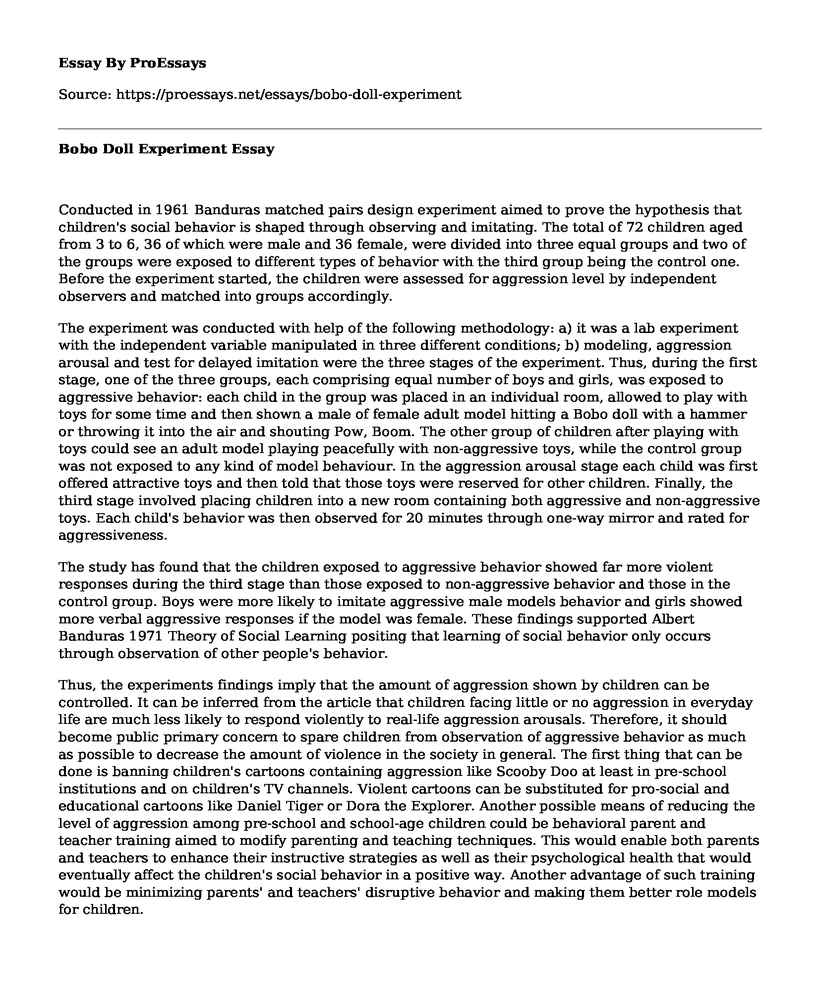Conducted in 1961 Banduras matched pairs design experiment aimed to prove the hypothesis that children's social behavior is shaped through observing and imitating. The total of 72 children aged from 3 to 6, 36 of which were male and 36 female, were divided into three equal groups and two of the groups were exposed to different types of behavior with the third group being the control one. Before the experiment started, the children were assessed for aggression level by independent observers and matched into groups accordingly.
The experiment was conducted with help of the following methodology: a) it was a lab experiment with the independent variable manipulated in three different conditions; b) modeling, aggression arousal and test for delayed imitation were the three stages of the experiment. Thus, during the first stage, one of the three groups, each comprising equal number of boys and girls, was exposed to aggressive behavior: each child in the group was placed in an individual room, allowed to play with toys for some time and then shown a male of female adult model hitting a Bobo doll with a hammer or throwing it into the air and shouting Pow, Boom. The other group of children after playing with toys could see an adult model playing peacefully with non-aggressive toys, while the control group was not exposed to any kind of model behaviour. In the aggression arousal stage each child was first offered attractive toys and then told that those toys were reserved for other children. Finally, the third stage involved placing children into a new room containing both aggressive and non-aggressive toys. Each child's behavior was then observed for 20 minutes through one-way mirror and rated for aggressiveness.
The study has found that the children exposed to aggressive behavior showed far more violent responses during the third stage than those exposed to non-aggressive behavior and those in the control group. Boys were more likely to imitate aggressive male models behavior and girls showed more verbal aggressive responses if the model was female. These findings supported Albert Banduras 1971 Theory of Social Learning positing that learning of social behavior only occurs through observation of other people's behavior.
Thus, the experiments findings imply that the amount of aggression shown by children can be controlled. It can be inferred from the article that children facing little or no aggression in everyday life are much less likely to respond violently to real-life aggression arousals. Therefore, it should become public primary concern to spare children from observation of aggressive behavior as much as possible to decrease the amount of violence in the society in general. The first thing that can be done is banning children's cartoons containing aggression like Scooby Doo at least in pre-school institutions and on children's TV channels. Violent cartoons can be substituted for pro-social and educational cartoons like Daniel Tiger or Dora the Explorer. Another possible means of reducing the level of aggression among pre-school and school-age children could be behavioral parent and teacher training aimed to modify parenting and teaching techniques. This would enable both parents and teachers to enhance their instructive strategies as well as their psychological health that would eventually affect the children's social behavior in a positive way. Another advantage of such training would be minimizing parents' and teachers' disruptive behavior and making them better role models for children.
Cite this page
Bobo Doll Experiment. (2021, Mar 09). Retrieved from https://proessays.net/essays/bobo-doll-experiment
If you are the original author of this essay and no longer wish to have it published on the ProEssays website, please click below to request its removal:
- Gender and Family Structure Essay
- Special Purpose Districts in Texas - Essay Sample
- Essay Sample on Committed Romantic Relationships
- Essay on Social Comparison Orientation & Group Membership: Effects on Similarity-Attraction
- Friends With Similarities and Differences: Examining Personality Traits - Essay Sample
- Children Who Have Experienced Abuse - Research Paper Sample
- Adult Education - Report Example







